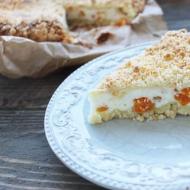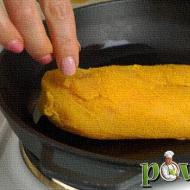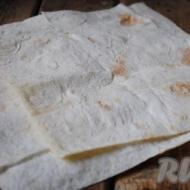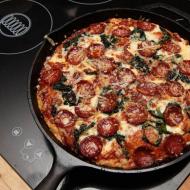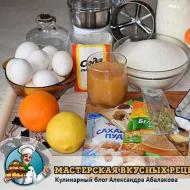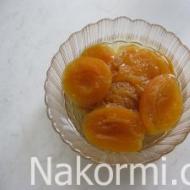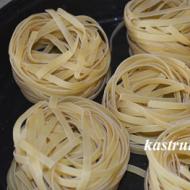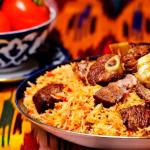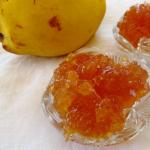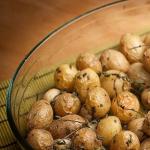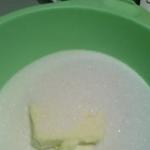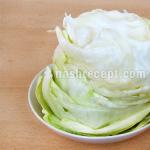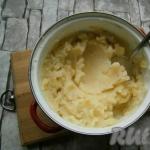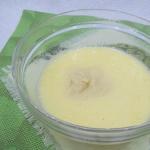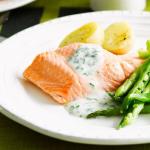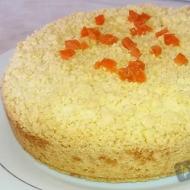
Food is Azerbaijani cuisine. Azerbaijani dovga
The main feature of local cuisine is its widespread use lamb, a huge amount spices, greenery, vegetables And fruit(including dried), fat tail fat, a large number of dishes made from sour milk and greens.
At the same time, in different parts of the country even such traditional dishes as shashlik or pilaf, cook in their own way.
Azerbaijani cuisine It is known for its abundance of vegetables in all types, primarily greens, eggplants, bell peppers, green beans, etc.
Fresh vegetable salads are almost always present on the table, and vegetables are usually cut very finely and generously seasoned with herbs, fermented milk products, vegetable oil and various sauces.
At the same time, local chefs actively use various marinades and pickles.
Worth attention" kyukyu" (a mixture of various types of greens and vegetables, beaten with egg and fried), " fisinjan"beans, marinated and stuffed tomatoes and peppers, potato kebab, eggplant kebab, eggplant chihyrtma, radish and vegetable salad" bahar", dishes of boiled beans with herbs and walnuts - " Fasinjan" And " lobby", as well as numerous vegetable side dishes, which are essentially complex salads that accompany most dishes.
At the same time, " abgora"(juice of unripe grapes), " azgil-sharab"(loquat extract), " albuhara"(dried plum of a special variety), " mountain" (unripe grapes) " doshab" or " Dushab"(boiled grape or mulberry juice), " narsharab" (pomegranate juice), " dogwood-ahata"(dried dogwood fruits), " sumac" (the peel of the fruit of a shrub of the sumac family) and other rather unusual ingredients.
Local soups They are so thick and rich that they often replace a full second course on the table.
Worth a try " turshu-syyig"(green cabbage soup), " ovduh"(a kind of okroshka), " balva"(soup made from rice, flour, butter, herbs and eggs), " Sulu-Hingal"(lamb broth with peas and dumplings), " shorba"(soup of rice, peas and fruits in meat broth), a thick soup well known to all Caucasian peoples" hash"("kyalla-pacha"), broth with herbs and saffron or pomegranate,
"dovga" (a kind of dish made from fermented milk products, rice and flour with various additives - meat, peas, herbs, etc.), " umach" (onion soup with tiny balls of dough), "hamrashi" (bean and noodle soup), " sujuk" (sweet soup made from flour or starch with nuts, butter and saffron) and " viper"(broth with boiled open lamb dumplings with fat tail and onions).
Meat dishes- a separate and very interesting article on local traditions.
The calling card of Azerbaijani cuisine is traditional pilaf, of which there are dozens of varieties - " kaurma pilaf"(with stewed lamb), " pilaf sabza kaurma"(with stewed lamb and herbs), " toyug pilaf" (with Chiken), " width pilaf"(with dried fruits), " syudlu pilaf"(milk)" brocade-doshamya"(with pieces of fried lamb), " Shuyud-pilaf"(with omelet and dill), " Mayvya-pilaf"(with stewed fruit), " Shashandaz-pilaf" (with scrambled eggs), etc.
Another culinary attraction of the country is kebabs(Karski style, sturgeon, lula kebab, tava kebab, sham kebab, judzha kebab, etc.).
No less popular" dolmas"(dolma - a kind of cabbage rolls made from grape leaves, cabbage, sorrel, pepper and even fruit with meat and other fillings), dozens of types kourma(boe-kourma, nar-kourma, turshu-kourma, sobza-kourma, etc.) and " kyuftas" (arzuman-kufta, "chykhyrtma", " jiz-byz"(lamb intestines fried with liver and potatoes), riza-kufta, etc.), " obrishta"(fried chicken in dogwood sauce), " tawa-eti"(fried lamb with vegetables), " turach"(fried game),
"Kashkaldaki", "azm" (minced liver fried with spices), " soyutma" (cold boiled lamb with tomatoes and herbs), " piti"(lamb stewed with peas with the addition of saffron and other spices), " dushbara" (a kind of small dumplings boiled in bone broth), " gymya" (fried minced meat with sultanas and dried apricots), " kutaby" (a kind of fried pies with meat or herbs), " dushpara" (small meat balls in dough), etc.
Many meat dishes are served with sheep cheese, cottage cheese and fermented milk products.
The long sea coast determines the abundance on the tables fish and seafood dishes- stuffed fish in Azerbaijani style, fish ("kutum") fried in a tandoor (a special type of open oven), stuffed fish " kutum lavengi", fish dolma, salad " Khazars"(salmon, sturgeon and caviar with a variety of herbs and vegetables), vegetable salad with red caviar, various dishes with sturgeon caviar and simply fried fish with a variety of local seasonings.
All dishes are served with " churek" (white flour bread) and all kinds of pita bread.
Sweets and baked goods, unlike other eastern countries, are used here much less frequently, although the local chefs cannot deny the art of their preparation - “kozinaki”, “sheker-bura”, “nogul”, “goz halva”, “baklava”, “shaker- churek", "shaker-bura", "shaker-pendir", "kurabye", "nan", "nogul bitmish", "Ordubad roll", "kyata", "tel" (terhalva), "tykhma", "kulcha ", "parvarda", "gyrmabadam", "mutaki", "peshvenk", "feshmek", all kinds of Turkish delight and other sweets are widely known outside the country. Local preserves and jams are also very good.
Tea in Azerbaijan drink always and everywhere! It is served to guests before the meal, while away the time and conversation in the teahouse, and ends the feast with it.
At the same time, not only traditional Black tea, but also various types of this drink with the addition of cardamom, thyme, rose water, cinnamon, ginger, etc.
Also one of the national drinks is " sherbet"(infusion of berries, citrus and other fruits with all kinds of additives, herbs, ice and sugar).
Popular black coffee(usually prepared in oriental style) and excellent local mineral water ("Badamly", "Turshu-su", "Isti-su", "Sirab", "Darydag", etc.).
They are famous for their excellent quality Azerbaijani wines, cognacs And brandy(local varieties “Bayan-Shiraz”, “Tabrizi”, “Tavkveri”, “Ag-Shany”, “Gara-Shany”, etc. are equally well suited for making light wines and strong drinks).
Azerbaijani cuisine, in terms of the composition and variety of dishes, is one of the extremely tasty and healthy cuisines. It is distinguished by an abundance of various meat (lamb, beef, poultry), fish (stellate sturgeon, sturgeon) and vegetable dishes, complemented by aromatic herbs and spices, as well as a beautiful appearance.
November 12 is the Constitution Day of the Republic of Azerbaijan. This day is very important for the residents, because they began to live in an independent state. We invite you to get acquainted with the culture of the Azerbaijani people by preparing several popular dishes of national cuisine.
Azerbaijani national dishes have long been prepared in copper dishes. And now in many regions and rural areas of Azerbaijan, dishes cooked in copper pans are more tasty. Therefore, items of Azerbaijani national cuisine (saucepan, colander, basin, tray, slotted spoon, ladle, etc.) are mainly made of copper.
In Azerbaijani cuisine, pilaf is prepared with melted (or butter) cow butter. This oil does not withstand high temperatures, and therefore the occurrence of carcinogenic substances does not occur. Rice is boiled in boiling water, poured with oil and left to settle. The meat is stewed with onions, chestnuts and dried plums.
Before eating the main meal, Azerbaijanis drink tea, mainly black baccalaureate. There has long been a tradition in Azerbaijan: immediately upon the arrival of guests, serve them tea. The advantage of this tradition is that drinking tea in crowded dinner parties encourages relaxed communication. Tea in Azerbaijan is a symbol of warm hospitality.
Our selection of Azerbaijani cuisine:
 OVDUKH (okroshka in Azerbaijani)
OVDUKH (okroshka in Azerbaijani)
Matsoni-200 g, water-100 g, fresh cucumbers-100 g, green onions-40 g, cilantro-10 g, dill-10 g, basil-5 g, 1 pc. eggs, beef-108 g, salt, garlic.
To prepare okroshka, matsoni is beaten and diluted with chilled boiled water. Peel the cucumbers, chop finely, then chop the greens. All this is mixed with diluted matsoni, salt and garlic are added and put in the refrigerator. Serve cold. In some cases, boiled and finely chopped beef and a hard-boiled egg are added to the ovdukh. Usually ovdukh is prepared without meat.
KHAMRASHI (Azerbaijani soup)
Lamb - 200 g, wheat flour - 30 g, eggs 1-4 pcs., ghee - 10 g, white beans - 20 g, wine vinegar - 10 g, onions - 20 g, cilantro - 20 g, dried mint -1.0 g, pepper, salt.
Minced meat is prepared from the lamb pulp, then it is cut into small balls of 5-6 pieces. per serving. The beans are cooked separately. Unleavened dough is rolled out to a thickness of 1 mm and cut into strips 5 cm wide, and cut into homemade arishta noodles. First, meat balls are boiled in the broth, then noodles and boiled beans are added. Once ready, add chopped herbs and sprinkle with dried mint when serving. Wine vinegar is served separately.
SHAKER-CHUREK
Wheat flour, premium - 530 g, ghee - 260 g, powdered sugar - 300 g, eggs - 1 pc., vanillin - 3 g
Beat the melted butter with powdered sugar for 25-30 minutes, while gradually adding egg white. Add vanillin and sifted flour and, rubbing thoroughly, knead into a stiff dough. The dough is formed into round balls weighing 60-75 g, placed on iron sheets lined with parchment, brushed with egg yolk on top and baked at a temperature of 175-180 degrees Celsius for 25-30 minutes. After cooling, the shaker churek is sprinkled with powdered sugar.
FIRNI
Rice - 40 g, milk - 200 g, sugar - 10 g, butter - 10 g, cinnamon - 0.2 g, salt
Rice is soaked in water for 2-3 hours, discarded, dried and pounded in a mortar. Pour rice flour into boiling milk, add salt and sugar with continuous stirring and cook. When serving, top with butter and sprinkle with cinnamon in a lattice pattern.
JYZ-BYZ
Lamb intestines (processed) -140 g, heart-60 g, liver-67 g, kidneys-60 g, testes-50 g, onions-50 g, potatoes-193 g, tail fat-15 g, greens-5 g , sumac-1.0 g, pepper-0.1 g, salt, in summer you can add tomatoes -100g
The cleaned intestines are cut into pieces 2-3 cm long. The liver, heart, livers and testes are cut into pieces. All this is peppered, salted and fried. Then add onions, separately fried potatoes, cut into cubes, mix and bring to readiness. When serving, sprinkle with herbs and serve sumac separately.
KUTABS WITH MEAT
Lamb-100 g, onion-20 g, lavashana-15 g or pomegranate-20 g, wheat flour-110 g, ghee-30 g, sumac-3 g, pepper-0.1 g, salt.
A stiff dough is kneaded from wheat flour with the addition of salt, which is rolled out to a thickness of 1-0.5 mm, and circles the size of a pie plate are cut out of it. Prepare minced meat from lamb and onions, add pepper, salt, pomegranate and mix thoroughly. Wrap the minced meat in dough in the shape of a crescent and fry in a frying pan in oil.
KUTABY WITH GREENS
Greens (spinach - 150 g, sorrel - 150 g, green onions - 150 g, cilantro and dill - 15 g), flour - 140 g, melted butter - 20 g, butter - 20 g, pita bread - 10 g, egg - 1/5 pcs, matsoni - 50 g, pepper, salt
The greens are washed, coarsely chopped and stewed with sautéed onions. Add salt, pepper, lavash to the filling and mix thoroughly. A stiff dough is kneaded from flour with the addition of water, eggs and salt, which is rolled out and cut into circles. The finished filling is wrapped in a crescent-shaped dough and fried on both sides in a frying pan without oil. When serving, kutabs are poured with heated butter and matsoni (kefir, yogurt) is served separately.
DOLMA
Lamb - 100 g, rice - 30 g, onion - 20 g, greens (cilantro, dill, mint) - 15 g, grape leaves - 40 g, matsoni - 20 g, melted butter - 10 g, salt, pepper, cinnamon
Lamb pulp and onions are passed through a meat grinder. Rice, chopped herbs, salt, pepper, and sometimes split peas pre-soaked in water are added to the minced meat. Fresh grape leaves are scalded with boiling water, and pickled leaves are left until half cooked. The minced meat is thoroughly mixed and wrapped in each sheet at the rate of an average of 25 g of minced meat per dolma. Place the dolma in a saucepan with a thick bottom, fill it halfway with water and simmer for an hour until cooked. When serving, matsoni (kefir, yogurt) is served separately.
LYULYA - KEBAB
1 kg of fatty lamb (if the lamb is lean, add tail fat or beef kidney fat), 4 medium onions, hot capsicum, a bunch of cilantro, 4 cloves of garlic.
Pass the meat, onion, garlic and cilantro through a meat grinder. Beat the minced meat very carefully on the table. You should feel with your hands that the meat has become sticky enough and does not fall apart. Then put the minced meat in the refrigerator for half an hour. Next, thread the minced meat onto a skewer into sausages 15 cm long (50 g each), and hold the skewer flat while threading. Fry on the grill for 10 minutes or on a preheated grill for 20 minutes. Lula kebab is usually served on thin lavash.
DUSHBARA (dumplings in Azerbaijani style)
lamb (boneless) - 400g, flour - 2 cups, egg - 1 pc, onion - 2 pcs, butter (melted) - 2 tbsp, wine vinegar (3%) - 2 tbsp, mint , cilantro - to taste, pepper and salt - to taste.
Separately, cook the bone broth. The lamb pulp is passed through a meat grinder, onion and pepper are added and mixed well.
A stiff dough is prepared from flour and eggs with the addition of salt. The resulting dough is rolled out to a thickness of about 2 mm. Stepping back 3 cm from the edge of the rolled out cake, spread the minced meat with a teaspoon at small intervals. The workpiece is covered with another cake, after which it is removed with a round recess.
The finished dushbara are dipped into boiling, strained broth and simmered over low heat until the dushbara float to the surface. For 4 servings use 6 cups of broth.
When serving, the dushbar is poured with broth, melted butter is added and sprinkled with herbs, and vinegar is served separately.
CHYKHYRTMA FROM SPINACH
Spinach-350 g, sorrel-100 g, parsley or dill-15 g, onion-50 g, eggs-2 pcs., melted butter-30 g, matsoni-100 g, pepper, salt.
Spinach, sorrel and parsley are sorted, washed, coarsely chopped and stewed. Separately fry the onions, then mix them with stewed herbs. Season with spices, place in a frying pan, pour in beaten eggs and bake in the oven. The finished dish is poured with oil and matsoni (yogurt, kefir) is served separately.
AZERBAJAN PILV
For pilaf you will need:
1) Dishes, preferably a cauldron
2) Oil - vegetable, in the original - cotton, you can use any other oil that you are used to using when frying, so that it does not burn.
3) Meat - classically, lamb, and, oddly enough, brisket is valued. It’s good to add the back, tail part (tail fat). But you can take other meat that is available to you. This dish is truly folk, even tough meat is prepared, but it is not necessary for guests to take just that.
4) Rice - not long, “Indian”. Here the principle is different - the rice should be translucent. The fact is that the rice should not fall apart during the cooking process, it should remain somewhat firm, although not raw.
5) Carrots - use white ones.
6) Onions - take white ones, as they are sweeter and juicier. But regular yellow is also perfect.
7) Garlic - per kilogram - 5-6 large heads, less is possible.
8) Spices - a mixture of medium-hot red pepper, sweet red pepper, barberry berries (for sourness), coriander - grains (these are cilantro seeds) cumin (cumin, sometimes in a shell, then these are narrow small seeds of a grayish color, as usual, and peeled, very small oblong seeds are usually black; if ground, they smell like something like petroleum products), a little cumin, dried tomatoes, saffron, dried garlic and other ingredients.
9) The ratios of products are approximately the following: for 1 kg of rice take 1-2 kg of carrots (less than 1 kg is not allowed), 1 kg of meat, 0.5 kg of onions, 0.3 - 0.4 liters of oil.
For vegetarians - everything is the same, only without meat. Instead of meat, add carrots or potatoes. There are fans of different combinations of pumpkin, raisins and other things. Important - the basic technology remains the same.
Wash the rice to remove the flour. Then soak. Pour oil into a bowl free of water (can be evaporated). It is heated over high heat so that the smell of what the oil is pressed from (sunflowers, olives, etc.) goes away.
To prevent sudden boiling of the oil, you can pour a pinch of salt into the already heated liquid.
Cooking technology:
1) In the heated oil, carefully so as not to splash, put fat (tail fat or from meat, if there is a lot of it), bones, which have no prospects for distribution as meat, for frying. When the fat is rendered, all the greaves are caught. No more oil is added during the cooking process.
2) Add prepared thinly sliced onions in advance or during frying. The onion is cut thinly so that it cooks properly.
3) Place the meat, cut into large pieces, and fry.
4) Place carrots cut into strips.
5) All this is fried over high heat, stirring gently with a slotted spoon so as not to chop the carrots. You will also need to boil water, first two liters, then three more, so that you can add it to the pilaf (you can use broth).
5) Add boiling water so that it covers the resulting mixture by about a finger, maybe a little more, bring to a boil, add spices, garlic in the form of whole heads, freeing it only from the dirty outer shells. Cook over low heat, without letting it burn, you can cover it for at least half an hour, you can simmer it longer.
6) Remove the garlic if you put it in. Using a slotted spoon, add rice (preferably pre-soaked) without MIXING IT with meat and carrots. This is how he will prepare until the very end of the process. The only difficult and decisive moment comes. You add boiling water to rice. About one and a half to two fingers above the rice. But it also depends on the type of rice, quantity of carrots, etc. After this, the rice is not mixed in the usual way, and water, as a rule, is not added. If you have strong doubts about what is happening at the very bottom of the pan (whether it is burning), in such an emergency, you can try by moving a slotted spoon along the wall to lift the food at the bottom. But it’s better not to let it come to that.
During the cooking process, you can pierce the rice to the bottom with a round stick made of wood that does not taste bitter, creating boiling “wells” evenly over the surface so that there are no stagnant zones. The top layer of rice can be carefully turned over with a slotted spoon so that no dried or uncooked grains are caught.
7) When the visible part of the liquid disappears, put the garlic back, carefully pounding the rice on top so that the garlic is completely covered by the pilaf. Cover the cauldron with a lid and leave for 30 minutes over very low heat.
8) Remove the pilaf from the heat, open it, remove the garlic, mix the pilaf carefully with a slotted spoon, shifting the layers. If the dishes are small, use additional ones. If you have time, you can let the pilaf stand in a warm place, stirring, soaking.
The finished pilaf is distributed in the form of large portions, in a whole soup plate, or laid out on a common large dish - “lagan”. The meat is placed on top, as well as garlic heads, usually one per guest. Serve with onion salad (just onions sprinkled with salt) and fresh tomatoes.
It is considered extremely impolite to call the offered pilaf porridge, use ketchup with it, etc. Be sure to serve unsweetened green tea at the same time.
Azerbaijanis love and know how to cook deliciously, but strict religious norms dictate certain restrictions for Muslims. Islam also left its mark on the national dishes of Azerbaijan. Recipes, for example, call for any meat except pork.
Azerbaijani cuisine
A characteristic feature of Azerbaijani cooking, in contrast to Russian, is that here in every kitchen there is always a strong aroma of spices. It is customary to complement Azerbaijan with a generous set of spices. are used in huge quantities. These are such well-known plants as basil, mint, dill, parsley, as well as sumac, saffron, cumin, fennel, various types of pepper, cinnamon, cloves and many others.
National dishes of Azerbaijan include all kinds of vegetables and fruits. Even in soups and hot meat snacks, fresh and dried cherry plums, grapes, figs, apples, apricots, plums, barberries, pomegranates, citrus fruits, etc. are added.
Azerbaijani chefs also know a lot about preparing desserts. Various dried fruits and nuts are crushed and, together with cinnamon, honey, saffron and mint, improve the taste of original sweets - nougat, Turkish delight, firni, baklava, kurabye, halva. They are also used for filling shor-kogal, shakerbura, zeyran, mutaka, kyata and many other sweet products made with or without dough.
For cooking, housewives take special containers - cauldrons, pitishniki, saji, tandoors and others, but this is not a mandatory requirement, they are just very convenient and, as a rule, have thick walls and special cavities for hot coals or electric heaters.

Baku pilaf
Azerbaijani pilaf with dried fruits and meat is a complex dish that is prepared in several stages.
Rice is cooked separately - 1 kg of cereal should be poured into a cauldron with plenty of cold water and put on fire. When it boils, add 2 tbsp. spoons of salt. Cook the rice until half cooked, then rinse with hot water and drain in a colander.
5-6 tablespoons of ghee are poured into the bottom of the cauldron, a flat cake is placed on the butter, and prepared rice is poured onto it in a heap. Add half a glass of saffron infusion, cover with a lid and simmer over low heat for about an hour.
Nar guvrum is prepared separately - it is usually lamb, but you can also use chicken. For the dish you need to cut 1 kg of meat into pieces, add salt, pepper, sprinkle with cumin and place in a roasting pan with melted butter. Fry over high heat. At the end, add two heads of finely chopped onions and dried fruits (apricots, figs, prunes, sultanas and barberries). Stir and pour in hot water with half a glass of saffron infusion. Simmer until the meat is done.
When setting the table, place the rice with the gazmakh broken into pieces on a large dish, spread the nar guvruma beautifully and sprinkle with pomegranate seeds.
Azerbaijani pilaf with dried fruits and meat can be made in a slow cooker. In this case, the cooking time will be significantly reduced.

Lamb offal dish
This dish is called jiz-byz. It uses the intestines, heart, lungs, testes, kidneys, liver and fat tail fat of a young sheep, as well as 2 onions, potatoes and spices (pepper, sumac, cumin, salt).
Jiz-byz, like many national dishes of Azerbaijan, is cooked in a special cauldron.
It is melted in a cauldron, and washed and cut into small pieces, giblets, spices and chopped onions are placed in it. Everything is fried over high heat, then potatoes are placed in the cauldron and hot water is added. Everything is stewed for about 40 minutes. Served sprinkled with cilantro, basil, dill and other herbs.

Khamrashi soup
Azerbaijani soup Khamrashi is prepared just before serving, as noodles are added to it, which lose their taste due to being in the broth for a long time. As for the beans, it is better to cook them in advance or soak them overnight.
National dishes of Azerbaijan are often prepared from young lamb with the addition of legumes. Khamrashi is no exception. For it, the meat should be minced and combined with salt and pepper. Add salt and spices to the pan with boiled beans. Bring to a boil, form the minced meat into large meatballs, place them in the pan and leave to cook.
Prepare unleavened dough from flour and water, roll it into a very thin layer and cut into small strips. Place the resulting noodles in a pan with beans and meatballs. Bring to a boil and turn off the heat.
Serve generously sprinkled with chopped cilantro, basil, mint, coriander and parsley.

Azerbaijani okroshka ovdukh
Azerbaijani-style okroshka is made not with kvass, but with the fermented milk drink matsoni. The composition of ovdukh includes boiled eggs, fresh cucumbers, green onions, cilantro, dill and garlic, mashed with salt. All of the listed components need to be cut, put in a plate and poured over the matsoni. The ingredients are combined immediately before serving, and before that they are stored separately in the refrigerator.
Sometimes pieces of boiled lean beef are added to okroshka.

Chagyrtma
National dishes of Azerbaijan rarely leave anyone indifferent. This also applies to Chagyrtma. The tasty and nutritious dish includes a lot of onions, chicken with bones, eggs, butter, bell peppers, fresh tomatoes, aromatic herbs and dry spices.
The chicken must be cut into small pieces, 60 grams each, salted, sprinkled with spices, poured with a small amount of grape vinegar and left to marinate.
Dip 1 kg of tomatoes into boiling water and remove the skin.
Finely chop one to one and a half kilograms of onions, add salt, add pepper, cumin, saffron infusion and simmer in a cauldron until soft and puree-like. To prevent the onions from burning, add hot water little by little, but not oil.
Mix butter, 200 grams, with onion, 45 minutes after the start of stewing.
After another 5 minutes, put the chicken pieces in the onion and simmer everything together for about 30 minutes.
Break 8-10 eggs into a bowl and lightly beat with a whisk to obtain a homogeneous cream-colored mass. Pour it into the cauldron, stirring constantly.
Immediately after this, cut the tomatoes into small pieces and place in a cauldron. Chop bell peppers and herbs there. Bring to a boil and turn off. Serve hot, placing on separate serving plates.

Lula kebab
Lula kebab is unique. To prepare it, you need to get special flat skewers.
Minced meat is traditionally made from fatty lamb, onions, cilantro, basil, parsley, salt and ground seasonings - pepper, sumac and cumin.
Short, thick sausages are formed from the minced meat and strung on skewers, and then fried on the grill. To make the minced meat viscous, it is passed through a meat grinder twice or kneaded for a long time in an electric processor with knives. After this, the minced meat is beaten on the table and placed in a cold place for 30 minutes. Even without eggs, after such preparation it holds very firmly on the skewer without losing its shape. The finished sausages are placed on thin pita bread and eaten, washed down with warm matsoni.
Lavash is made from unleavened dough consisting of flour, water and salt. To prevent cracks from appearing on the lula kebab when rolling, it must turn out thin and plastic, which is why Azerbaijani lavash is not fried in oil, but baked in a tandoor and used for lula kebab not immediately, but after it has rested and become soft . Since not everyone has a tandoor, it can be successfully replaced by a cast-iron frying pan with a thick bottom.

Dolma
Dolma are very small cabbage rolls that are wrapped not in cabbage, but in grape leaves.
Minced meat is made from lamb, boiled rice, pea puree, onions, salt, pepper and cilantro, basil, parsley and celery. They take half as much rice and peas as meat. The spicy leaves are chopped very finely, and the meat along with the onions is passed through a meat grinder. All ingredients are thoroughly mixed and placed with a teaspoon on grape leaves scalded with boiling water. The leaves are wrapped and dipped in salted boiling water. Cooking time - 30-40 minutes. Dolma is eaten hot, seasoned with matsoni.

Khinkali
Khinkali in Azerbaijani is a product made from unleavened dough, reminiscent of noodles, only more coarsely chopped. Nothing is added to the dough except water and wheat flour. In the cuisines of other nations, khinkali is a cross between dumplings and manti, that is, with filling. Khinkali in Azerbaijani - simple flat squares of dough. They are added to a variety of first and second courses. Khinkali is also served separately, with some kind of sauce, for example, garud sauce and gyimya meat.
For gyim, minced meat is stewed with spices and grape vinegar until soft.
Garud is a sauce made from matsoni and garlic, ground with salt.
Khinkali boiled in salted water is placed on a plate, gyimya is placed on it, garud is poured on top and sprinkled with chopped herbs.

Kutaby
To make kutabs with meat in Azerbaijani style, you need to prepare the dough and minced meat.
The dough requires wheat flour, a little salt and water. It is kneaded quite steeply so that you can roll out a thin flat cake from which to cut out circles with a diameter of 17-19 cm. Place minced meat in the middle, fold the dough in half, like pasties, seal the edges tightly. Fry in a frying pan with oil.
Kutabs with meat in Azerbaijani style are prepared from lamb, so they must be eaten hot, sprinkled with sour sumac. Onions, pieces of sour flatbread made from dried apricots and other fruits, pomegranate juice, salt and pepper are added to the minced meat.

Shaker-churek
This is a traditional sweet dish served with tea. It is very easy to prepare. From 1 kg of wheat flour, two beaten egg whites, half a kilogram of butter and the same amount of powdered sugar, you need to knead the dough and roll it into balls. Dip each ball in the yolk and place on a baking sheet covered with Teflon paper. Bake in a hot oven until golden brown. Place the finished Shaker-Churek balls on a dish and sprinkle with powdered sugar mixed with vanilla or cinnamon.
Firni
Firni is another dessert dish that resembles a very thick jelly or milk porridge. It is not much more difficult to make than shaker churek, and its unusual taste and consistency will surprise those who are not familiar with Azerbaijani cuisine. For firni you need rice flour (100 g), half a liter of milk, a tablespoon of ghee, the same amount of sugar, a little salt and ground cinnamon.
If there is no rice flour, then use regular white rice, grinding it in a coffee grinder. Pour rice flour into boiling milk in a thin stream, add sugar and salt and cook over low heat, making sure it does not burn. At the very end, add butter and stir thoroughly. Serve to guests by pouring into cups and sprinkling cinnamon on top.
Ingredients
- Matsoni (kefir) (1 l) - 5 glasses
- Flour (30 g) - 1 tablespoon
- Water (400 g) - 2.5 cups
- Chicken egg - 1 piece
- Butter or full-fat sour cream - 30 g
- Round rice (60g) - 2 tablespoons
- Greens: spinach, dill, cilantro, mint, leeks - 10-15 sprigs each
- Chickpeas (50g) - a quarter cup
- Table salt - 1 tablespoon (to taste)

Dovga is a light first course of Azerbaijani national cuisine. The basis for preparing dovga is matsoni (in Azerbaijan it is called gatig) and greens. On hot summer days, dovga is consumed chilled. In winter, dovga can be served hot. Preparing the dish takes about one hour.
How to cook Azerbaijani dovga
A few hours before cooking, or better yet, in the evening, you need to soak the peas, after which they are boiled in salted water for about half an hour until tender.

Peel the greens from roots, rough stems and yellowed leaves, rinse and finely chop.

Sort the rice, rinse and put in a saucepan in which the dovga will be cooked, add flour, egg, and salt. Mix the resulting mass thoroughly so that there are no lumps of flour left.

Stirring thoroughly until a homogeneous emulsion is obtained, add matsoni, softened butter or sour cream and water to the pan. At this stage of cooking, you can use a mixer to achieve a homogeneous consistency.

Place a saucepan with a homogeneous mass over medium heat and bring to a boil, constantly stirring the contents of the pan. If you stop continuous stirring, the resulting mass may curdle - the liquid phase will separate from the solid and the result can be thrown away - nothing will come of it.
When the rice included in the dovga is almost cooked, without interrupting stirring, add finely chopped greens to the boiling mass. You need to cook the dovga until the rice and herbs are cooked. The rice should soften. Greens should not squeak or crunch in your teeth. But at the same time, it should not be overcooked, since in this case the color of the dovga may acquire a greenish tint. Properly prepared dovga has a uniform consistency, flowing silky texture and white color. At the end of cooking, previously boiled peas are added to the dovga.

When serving, hot dovga can be served in a soup bowl or portioned bowls. Chilled dovga can be served in a glass jug or immediately poured into glasses.

Not stopping there, MOSLENTA continues to ask representatives of various nationalities living in Moscow about what their culinary traditions are, where in the capital they recommend trying their cuisine, buying the “right” products and what to do with them.
This time, Azerbaijani cuisine is represented by the ex-director of the Baku International Film Festival “East-West” Lala Efendiyeva.
About Me
All my life I have been torn between Russia and Azerbaijan. I was born in Baku, lived in Baku, started studying at school in Baku, but graduated from it in Moscow, I studied at the institute in Moscow, but worked in Baku, and then I ended up in Moscow again, where I have been living for a year and a half. So I have the feeling that I myself am divided into two cities. Because of this, of course, many difficulties arose, but they did not concern the culinary aspect at all, because my mother cooks perfectly wherever she is, and from the products that can be bought. And now I cook well myself. So our home kitchen was not affected at all due to the move to Moscow.
About the kitchen
Our cuisine is completely special. I understand that every nationality says this, so I’ll try to explain. Unlike our northern neighbors, Azerbaijani cuisine never uses pork. We have a very wide representation of fish and poultry. But, the main thing is that in my homeland there is such an incredible amount of dishes that the concept of “Azerbaijani cuisine” has long become a brand - just like Azerbaijani carpets or a special type of music - Azerbaijani mugham.
And in Azerbaijan there is a real cult of food! Moreover, the majority here cooks, of course, national dishes. Yes, in my family they could, for example, cook borscht or cabbage soup, but this happened infrequently. Any feasts or holidays are always our, Azerbaijani food.
About memory
I have always loved food, especially as a child. Another thing is that, like any child, I, first of all, adored sweets. And our family prepared the most sweets for Navruz Bayram, celebrated on March 20-21.
We prepared carefully for this holiday - two, three weeks in advance. We prepared baklava and shakerbura. As a ten-year-old, I was sometimes tasked with using tiny tweezers to apply patterns to the Shakerbura. This is a very painstaking work, during which I constantly pestered my grandmother with questions about her, about her parents, about her grandparents. If it weren't for these conversations, I would never have known my family's history.
About pilaf
Azerbaijani cuisine has a lot in common with Persian cuisine, so the main dish in it is pilaf. It is worth talking about it separately, because it is prepared completely differently from, say, Uzbek. In our country, rice is boiled without any additives in salted water, discarded at a certain time, and then put on low heat so that it “cooks” and forms a crust. The rice turns out completely white and is laid out on a separate dish. And in other dishes it is served with a huge number of different additives: it can be meat with herbs, meat with chestnuts, chicken, something sweet.
About "eat"
Any of our feasts begins and ends with tea. And among the dishes, the first to be placed on the table are appetizers - cold and hot. What are hot snacks? Well, for example, kyukyu - stewed greens (parsley, cilantro, leeks, dill, green onions, and, most importantly, spinach), doused with beaten egg, and then cut into portions. Or levengi fish: fish (preferably kutum or trout), stuffed with ground walnuts mixed with dissolved cherry plum plate, and then baked in the oven. Boiled or baked sturgeon. Or here are vegetable snacks: fried eggplants, tomatoes.
Kufta-bozbash - chickpeas with meatballs. Khamrashi is a soup with an analogue of Russian noodles. Dushbara is a soup with tiny dumplings that fit ten in a spoon. After the first courses, meat is served. This could be bozartma (a kind of stew of meat with vegetables), sabzi govurma (a lot of greens stewed with lamb pulp). Potato? No? We don’t use it, because traditionally in Azerbaijani cuisine meat is combined with herbs, vegetables and fruits. The most commonly used seasonings are turmeric, dried mint and thyme.
Yes, talk about seasoning! I’ll tell you a family secret: my grandmother always added a couple of pinches of cinnamon to the minced lamb intended for dolma, which gives the dish an absolutely exquisite aroma. And yet - what if you don’t know? - Dolma does not have to be with grape leaves. We stuff eggplants, tomatoes and peppers with minced meat. Moreover, I ate apples stuffed with meat from my friends! This dish is called alma-dolmasy.
Do you think that's all? But no! After meat dishes, fish dishes are served. Then - pilaf. And, as I already said, tea.
In general, you understand: the main thing in our feast is to be able to stop on time.
About "drink"
The main traditional Azerbaijani drink is fermented milk ayran, to which salt, pepper and finely chopped herbs are added. And for sweets, these are, of course, sorbets - fruit, lemon. My grandmother often prepared a drink from purple basil, which we call reikhan. This is done simply: a washed bunch of reyhan is poured with boiling water, to which sugar syrup and a slice of lemon are immediately added. The resulting mixture should brew a little and cool, after which you can drink a very aromatic pale purple drink. A kind of homemade lemonade.
About speed
Most of our recipes are very labor intensive. What if guests came suddenly? Owners of their own homes can, of course, cook barbecue. But those who are in the apartment... The other day, just like that, suddenly, guests came to me. What have I done? I quickly used what was on hand: walnuts and quail, which can easily be replaced with chicken. So I ground the nuts.
I put cherry plum pastille on a frying pan (these are special thin plates sold in markets), poured boiling water over it and, stirring, dissolved it. I added nuts there. At the same time I cooked quail. I cut each into four parts, poured the sauce over it and simmered until all the liquid had evaporated and the sauce had thickened. It took me about half an hour to do everything... This dish is called sifinjan and can be eaten either separately or as an additive to pilaf.
About the recipe
One of the simplest Azerbaijani dishes is the hot appetizer kyukyu. For it you will only need one large bunch each of spinach, cilantro, dill, green onions and a leek. And also - 6 eggs, 50-70 g of melted butter or butter, a handful of chopped walnuts, salt, pepper and katyk (matsoni, kefir or yogurt).
So, let's get ready. Everything is very simple. The greens must be washed thoroughly. Then finely chop. Add eggs, salt and pepper to taste and mix well.
Grease the frying pan in which the kyukyu will be baked. Melt the rest of the butter and pour it over the top of the kyukyu.
Place a frying pan with this mixture in an oven preheated to 160-170 degrees. First, on the lower mode of the stove for 15 minutes, then on the upper mode for 15 minutes.
Carefully transfer the finished kyukyu to a plate and cut it into portions. Sprinkle generously on top with finely chopped, slightly roasted walnuts.

